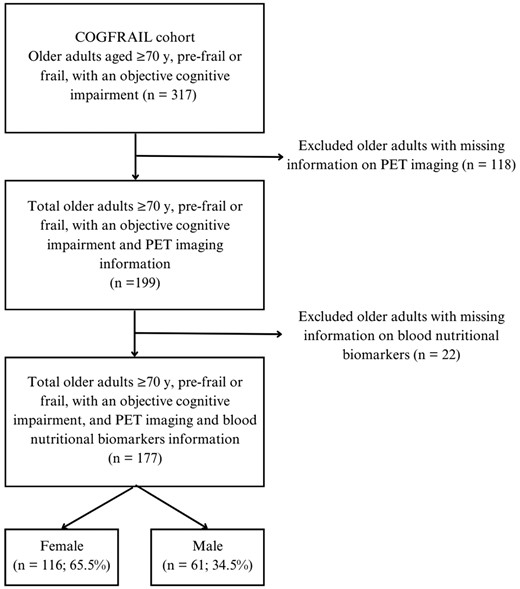A Cross sectional study in Alzheimer patients found that higher concentrations of a PCA factor composed of 3 polyunsaturated fatty acids correlated with lower beta amyloid plaques while linoleic acid correlated with higher levels. One of the 3 "beneficial" PUFAs was mead acid. This is the first time I've heard anything about mead acid outside of Ray Peat. The others were clupadonic acid and adrenic acid which I've never heard of. Clupadonic had the highest regression coefficient and t-stat (lowest p-value) by far of the "beneficial" PUFAs. Very interesting.
Of all 4 PUFAs linoleic acid had the largest magnitude (negative) coefficient.
I've only read the abstract but plan reading the full study.

 academic.oup.com
academic.oup.com
Of all 4 PUFAs linoleic acid had the largest magnitude (negative) coefficient.
I've only read the abstract but plan reading the full study.

Associations Between Blood Nutritional Biomarkers and Cerebral Amyloid-β: Insights From the COGFRAIL Cohort Study
Abstract. Understanding the relationship between blood nutrients and neurodegeneration could contribute to devising strategies for preventing Alzheimer’s d
@haidutUnderstanding the relationship between blood nutrients and neurodegeneration could contribute to devising strategies for preventing Alzheimer’s disease. We investigated the associations between fatty acids, vitamins D, B6, B12, folate, homocysteine, and the cerebral load of amyloid β (Aβ). This cross-sectional study included 177 older adults (70–96 years, 65% female) with objective cognitive impairment, prefrail, or frail. Cerebral Aβ load was determined using positron emission tomography Standardized Uptake Value ratios. Fatty acids were assessed in erythrocytes, vitamins D and homocysteine in serum, and the other vitamins in plasma. Linear regression models corrected for multiple comparisons evaluated the associations between each nutrient and Aβ. The principal component factor followed by linear regression grouped the fatty acids strongly correlated (factor) and associated with Aβ. Higher concentrations of polyunsaturated fatty acids (PUFAs): clupanodonic acid (22:5n-3; β: −0.13; p = .001), mead acid (20:3n-9; β: −0.07; p = .036), and adrenic acid (22:4n-6; β: −0.05; p = .031) were associated with lower global Aβ load, whereas linoleic acid (18:2n-6) was associated with higher global Aβ load (β: 0.18; p = .042). Clupanodonic acid was inversely associated with Aβ in all cerebral regions except the thalamus. The factor composed of mead, clupanodonic, and arachidonic (20:4n-6) acids was associated with a lower global Aβ load (β: −0.02; p = .002). Some erythrocyte PUFAs were inversely associated with Aβ load in the brain, and most of them were metabolites of the essential fatty acids linoleic and α-linolenic. Given the cross-sectional design, these results must be carefully interpreted, and longitudinal studies are needed



